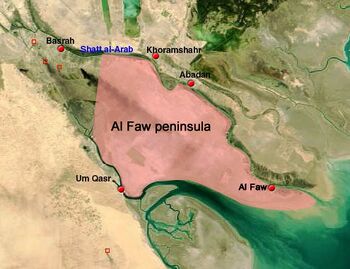شبه جزيرة الفاو
 | |
 |
- هذه المقالة عن شبه جزيرة عراقية. انظر أيضا الفاو نظام مدفعية.
شبه جزيرة الفاو ، هي شبه جزيرة تقع في الخليج العربي في جنوب شرق العراق في المنطقة بين مدينة البصرة العراقية ومدينة عبدان الإيرانية.
تتمتع شبه جزيرة الفاو بأهمية إستراتيجية كبيرة في المنطقة ، فهي من جهة منطقة غنية بالنفط ، ومن الجهة الأخرى يمر بها نهر شط العرب حيث يكون مصبه في نهاية مدينة الفاو ، وبالتالي تتحكم في الطريق المؤدي لميناء البصرة العراقي.
الحرب الإيرانية العراقية
كانت شبه جزيرة الفاو محتلة من قبل القوات الايرانية بداية من يناير 1986 بعد معارك ضارية تواصلت 45 يوما إلى أن إستردتها العراق بالكامل 17 أبريل -22 يوليو 1988.[1]
During the Iran–Iraq War in the 1980s, al-Faw was bitterly contested due to its strategic location at the head of the disputed Shatt al-Arab waterway and was the site of many large-scale battles. On February 11, 1986, the Iranians capitalized on the weakness of the Iraqi defences located at the southernmost tip of the peninsula by launching a surprise attack against Iraqi troops defending al-Faw. The Iraqi units in charge of the defences consisted mostly of poorly trained Iraqi Popular Army conscripts that collapsed when they were suddenly attacked by Iranian Pasdaran (Revolutionary Guard) forces.
It marked the first time that the Iranians had successfully invaded and occupied Iraqi territory. The Iranians defeated several Iraqi Republican Guard counter-offensives and managed to hang on to their foothold.
The occupation of al-Faw placed Basra at risk of being attacked. The Iranians also used the peninsula as a launch pad for Silkworm missiles which were deployed against shipping and oil terminals in the Persian Gulf, and also against Kuwait, which supported Iraq throughout the war.
On April 17, 1988, the newly-restructured Iraqi Army began a major operation, "Ramadan Mubarak," which was aimed to clear the Iranians out of the peninsula. The Iraqis concentrated well over 100,000 troops from the Republican Guard versus 15,000 second-rate Iranian Basij soldiers.[2]
By using sarin nerve gas,[3] artillery barrages and air bombardments, the Iraqis eventually expelled the Iranians from the peninsula within 35 hours, with much of their equipment captured intact. The event was marked as an official national holiday under the former regime of Saddam Hussein, celebrated as the Faw City Liberation Day.[4]
الإحتلال الأمريكي والبريطاني
The 1991 Gulf War was fought south and west of al-Faw, but the peninsula's military installations were heavily bombed by Allied forces during the conflict. The Allied forces effectively closed down all of Iraq's shipping activities and thus rendered its access to the Shatt al-Arab and the Persian Gulf useless.
The peninsula was one of the first targets of the Coalition forces in the 2003 invasion of Iraq, with British, American and Polish troops involved. Forces from the Royal Marines, US Marines and the Polish GROM staged a successful midnight amphibious assault on the peninsula. All of them were attached to the British 3 Commando Brigade.[5] Their goal was to secure the port of Umm Qasr to allow humanitarian goods to be shipped in, and to secure the key oil installations located in the area before they could be sabotaged by retreating Iraqi forces. The Mina al-Bakr oil terminal was seized by SEAL Teams 8 and 10; as well as US Navy EOD personnel.[6] The Khor al-Amaya oil terminal was seized by GROM operators.[6] The peninsula fell quickly with minimal Iraqi resistance, but unexpected fierce resistance in Umm Qasr required several days of fighting before the town had been secured.
The British, based at Camp Driftwood, provided the security and countersmuggling force on land, and the American forces providing maritime assistance. Camp Driftwood was handed to Iraqi control in March 2007 by troops from 1st Battalion The Yorkshire Regiment.
انظر أيضا
المصادر
- ^ موقع الرئاسة التونسية
- ^ Pollack, Kenneth M. (2004). Arabs at war: military effectiveness, 1948–1991. University of Nebraska Press. p. 225. ISBN 0-8032-8783-6.
- ^ خطأ استشهاد: وسم
<ref>غير صحيح؛ لا نص تم توفيره للمراجع المسماةForPolicy_Apr88_sarin - ^ Podeh, Elie; Pôde, Ēlî (2011-06-30). The Politics of National Celebrations in the Arab Middle East (in الإنجليزية). Cambridge University Press. p. 142. ISBN 9781107001084.
- ^ Operations in Iraq: Lessons for the Future. Ministry of Defence/National Archives. "The Al Faw Peninsula Operation" (sidebar), p. 11. Retrieved 16 January 2020 – via The Internet Archive.
- ^ أ ب Neville, Leigh (2008). Special Operations Forces in Iraq. Oxford: Osprey Publishing. p. 24. ISBN 978-1-84603-357-5.
- Pages using gadget WikiMiniAtlas
- Short description is different from Wikidata
- Infobox mapframe without OSM relation ID on Wikidata
- Articles using infobox templates with no data rows
- Pages using infobox islands with unknown parameters
- Coordinates on Wikidata
- أشباه جزر في آسيا
- مظاهر السحط في العراق
- صفحات مع الخرائط